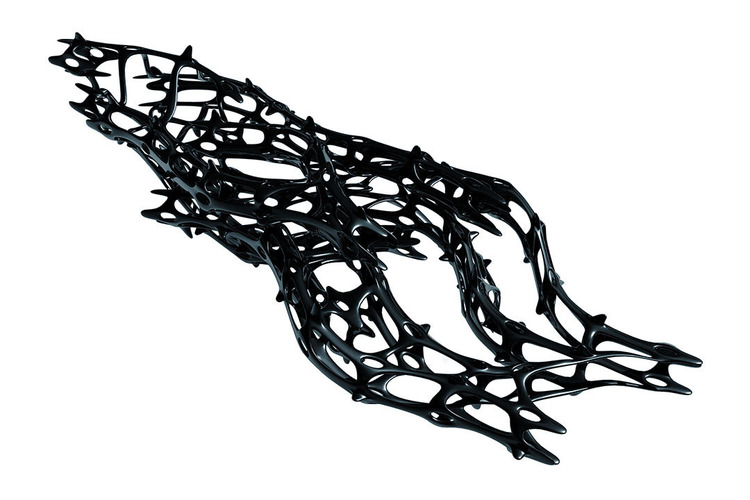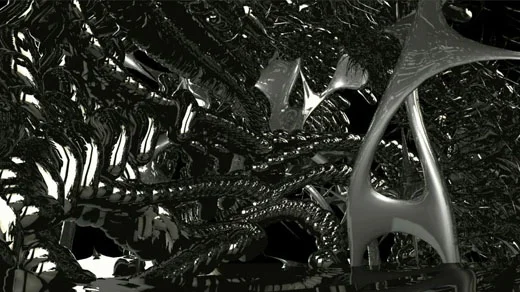I designed LGB in Hernan Diaz Alonso's studio at Columbia University in 2003. It is one of the earliest examples of the use of subdivision surface modeling in architecture and the first example of the single surface branching structure that has become an increasingly popular design technique.
Pegasus
Searching for something in my email I came across this amazing drawing done by Noah Olmsted, my partner in XV. If I remember correctly, this was made back when we were in studio with Jeff Kipnis and Greg Lynn at Columbia.
New Columbia GSAPP Website
Check out the NEW Columbia GSAPP Website designed by my classmate Gabe Bach.
Mega Brand Edge City / Final
Image by Santhosh Shanmugam
The final images from the Mega Brand Edge City studio I taught with Hani Rashid have been compiled and published in the studio section of this site. All past studios are now fully archived…time to write my brief for the Fall.
Accumulative Micro Behaviors / Final
Image by Erick Carcamo
I’ve compiled the final presentations from the Accumulative Micro Behaviors studio I taught with Hernan Diaz Alonso last Fall. The videos along with the studio brief are posted in the new studio section of this site.
Hot House(s) Final Projects
Image by Ifeanyi Oganwu
I’ve compiled the final presentations for the Hot House(s) studio I taught with Hani Rashid and Theo Lalis this last Spring. The videos along with the studio brief are posted in the new studio section of this site.
Mark Morris
As seen in our HotHouse(s) midterm review, Mark Morris's kinetic architecture follows the logic of a packing algorithm.
Ifeanyi Oganwu
This detail elevation shows Ifeanyi Oganwu’s eroto-organic living pods, as seen in our HotHouse(s) final review last week.
Hot House(s) Final Review
The final review for the studio I’m teaching with Hani Rashid and Theo Lalis will be this Wednesday at Columbia's GSAPP. [ 1pm room 114 Avery ]
Jury:
Barry Bergdoll
Mark Cousins
Lise Anne Couture
Tom Kovac
Thomas Leeser
Henry Smith Miller
Dylan Baker Rice
Mark Wigley
Agent Code Symposium at Columbia
I'll be speaking at the Agent Code Symposium on Wednesday, April 11th, 12:30-6:00 at Columbia University's Avery Hall. Description by Ed Keller below:
“… each portion of matter is not only infinitely divisible, as the ancients observed, but is also actually subdivided without end, each part into further parts, of which each has some motion of its own; otherwise it would be impossible for each portion of matter to express the whole universe. Whence it appears that in the smallest particle of matter there is a world of creatures, living beings, animals, entelechies, souls. Each portion of matter may be conceived as like a garden full of plants and like a pond full of fishes. But each branch of every plant, each member of every animal, each drop of its liquid parts is also some such garden or pond.”
Leibniz, Monadology
Cutting edge architectural work increasingly uses scripting and models of emergent and embedded behavior to explain systems and to generate morphology. The patterns we discover in architecture, social structures, political bodies, and in the formal operations of the city, function as a spatio-temporal index of life and the substrates of reality itself.
HotHouse(s) Studio Assignment 01
Erase, Locate, Reconstitute, Reconstruct
Start with something inspired, reduced, and ambiguous. Abstract the conditions to the point of amnesia. Eradicate any semblance of a priori meaning. Build a functionless, scale-less, sensual, sophisticated, affective, operable, meaningful, textured, intimate architectural object. Locate a new materiality and research from within the abstract condition of your project
HotHouse(s): Prototypes, Assemblies and Architecture
I’m teaching studio with Hani Rashid again this semester, and we’re also adding Theo Lalis (former designer at Future Systems) into the mix.
The brief follows :
HotHouse(s): Prototypes, Assemblies and Architecture
Columbia GSAPP Advanced Studio VI
Spring 2007
Hani Rashid + Alex Pincus + Theo Lalis Sarantoglou
Ten years ago the Digital Design Studios were initiated at Columbia GSAP. It was a pivotal decade that brought some important discoveries to architectural theory and design mainly through the investigation of computation and the potential for new formal strategies and methodologies. Today a new approach and pedagogy should focus on the mutation and realignment of the original digital design initiatives to pursue a new pedagogical agenda. Experimentation in architecture is now in search of some deeper resonances and trajectories, in need of a new infusion of thinking that is more consequential. What is of interest presently can be found in the realms of radical engineering, innovative hybrid materials, new modes of digital fabrication and non standardization/mass customization as well as innovative strategies for environmentally responsive and intelligent buildings. Today we are embarking on a new phase that is clearly about a greater integration between the way architecture is conceived, iterated, fabricated and implemented. it is about achieving a greater level of control over the symbiotic relationship between technique, process, and outcome, even if that outcome is deliberately about the unpredictable and the speculative. This endeavor depends on the following:
Erick Carcamo
These stills are from Erick Carcamo’s phenomenal and terrifying final project for the Accumulative Micro Behaviors studio I taught with Hernan Diaz Alonso.
Phil Mana
Phil Mana’s exceptional final project for Accumulative Micro Behaviors engages themes of perversion and repetition.
Final Word
The final review for the studio I’m teaching with Hernan Diaz Alonso will be this Friday at Columbia. The critics include:
Jeff Kipnis
Francois Roche
Peter Cook
Preston Scott Cohen
Sanford Kwinter
David Ruy
Ferda Kolatan
Mark Gage
Mark Wigley
Should be interesting.
Accumulative Micro Behaviors | Innovation and Novelty
Hernan Diaz Alonso and I are co-teaching Adavanced Studio V at Columbia. We’re adjusting our approach to what we’ve been researching over the last few years. All elements are now required to be 1” x 1” x 1” or less, forcing larger scale effects to emerge via hyperindexical accumulations.
Accumulative Micro Behaviors | Innovation and Novelty
Columbia GSAPP
Advanced Studio V
Fall 2006
Hernan Diaz Alonso and Alexander Pincus
Historically architecture always starts with a concept, an overall strategy or some kind of pre meaning. The studio proposes to re examine the possibilities of form generation as an autonomous entity.
Dave Jackowski
David Jackowski’s project for this semester’s Mega Brand Edge City studio has achievied an incredible sophistication in surface geometry.
Mega Brand Edge City | Dubai
Hani Rashid has asked me to co-teach a design studio on Dubai at Columbia. We’re on the verge of some major projects there and will be using the studio as a laboratory to explore Dubai’s imagined but untapped architectural potential.
The studio brief follows:
Mega Brand Edge City | Dubai
Columbia GSAPP
Advanced Studio VI
Spring 2006
Hani Rashid and Alexander PincusDubai is a place of extremes, from it’s climate and physical context, to it’s economic and geopolitical strategies to it’s urban infrastructure and architecture. Here limits are constantly being tested and surpassed, producing a city that today is subject to a darwinian trajectory. Dubai is either quickly becoming one of the most extraordinary and evolved cities on the planet, or a travesty of extravagance and excess, the potential result of both misguided vision and ambitious yet flawed enterprise.
Hemostology Website
I’ve just finished designing a webpage for the studio I taught with Hernan Diaz Alonso at Columbia. It’s a pretty simple page that tries not to compete too much with the work, but still keeps the feeling of what we were after in the course. Click here to visit.
Greg Derrico
This is a great x-ray view through Greg Derrico’s super organic studio project.






